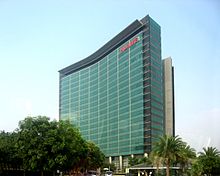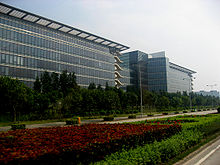Huawei
Huawei (Chinese 華為 / 华为, pinyin Huáwéi IPA [xwǎˈwěɪ] ![]() , official 華為技術公司 / 华为技术公司, Huáwéi Jìshù Gōngsī, English Huawei Technologies Co., Ltd. ) is a telecommunications equipment and hardware manufacturer founded in 1987 by Ren Zhengfei and headquartered in Shenzhen, a special economic zone in China, adjacent to the Hong Kong Special Administrative Region. The group had approximately 194,000 employees worldwide at the end of 2019.
, official 華為技術公司 / 华为技术公司, Huáwéi Jìshù Gōngsī, English Huawei Technologies Co., Ltd. ) is a telecommunications equipment and hardware manufacturer founded in 1987 by Ren Zhengfei and headquartered in Shenzhen, a special economic zone in China, adjacent to the Hong Kong Special Administrative Region. The group had approximately 194,000 employees worldwide at the end of 2019.
The 2020 annual revenue was about 116 billion euros, and the net profit was 8.4 billion euros. In April 2020, Huawei was the largest smartphone producer in the world, ahead of Samsung and Apple.
The company focuses on the development and manufacture of communication technology devices. This includes mobile communications (UMTS, GSM, GPRS, GSM-R, WiMAX), but also xDSL, optical networks, network components, WLAN access points, servers and switches. The European headquarters of the Huawei Group is located in Düsseldorf. Due to the tense political situation in Europe, which has security concerns in the supply of 5G components from Huawei, Huawei is planning a plant for 5G network technology in France to create greater acceptance and transparency.
History
First years
In the 1980s, the Chinese government began an attempt to modernize the country's previously underdeveloped telecommunications infrastructure. In the course of these modernization efforts, Ren Zhengfei founded Huawei in 1987 in the Shenzhen Special Economic Zone. His goal was to create a Chinese telecommunications company that could compete with foreign competitors.
The business model in the early years consisted mainly of reselling telephone equipment imported from Hong Kong. At the same time, Huawei made investments in research and development of its own technologies. In 1990, the company had about 500 research and development employees.
The first breakthrough came in 1993 with the C&C08 switching system, the most powerful of its kind in China at the time. After the technology was initially applied in small towns and rural areas, the market share grew over time. With the Chinese government's 1996 policy of promoting domestic telecommunications companies and restricting access for foreign competitors, Huawei was further strengthened.
International expansion
Huawei signed its first international contract with Hong Kong-based Hutchison Whampoa in 1997. This was followed by further contracts with international telecommunications companies and the opening of several research and development centres. Huawei first entered Europe in 2000, when it opened a research center in Stockholm. In 2002, international sales totaled $552 million.
Around 2002, the company was accused by the network component manufacturer Cisco that the hardware and software (IOS) of the devices were almost identical to Cisco products. In 2003, a US court partially upheld Cisco's claim, but only in the area of software. Eventually, Cisco and Huawei agreed to an out-of-court settlement. After third parties confirmed Huawei's compliance with the settlement in late 2004, Cisco did not pursue the allegations against Huawei. A patent filed by Huawei with the European Patent Office in December 2006 caused anger among experts, as Huawei allegedly took advantage of its cooperation with the IETF to now claim patent protection on a previously known process.
In 2005, foreign sales exceeded domestic sales for the first time. In June 2007, the Chinese business magazine Global Entrepreneur named Huawei the best Chinese company in Europe.
In 2008, Huawei established the joint venture Huawei Symantec with the American Symantec, based in Chengdu, China. Huawei held 51% of the company, while Symantec held 49%. In November 2011, Huawei fully acquired the joint venture, paying $530 million for Symantec's stake.
In March 2014, it became known through media reports that the US intelligence service NSA had spied on the Group.
At the end of February 2016, the start of a long-term strategic alliance between Huawei Consumer Business Group and Leica Camera AG was announced. Within the scope of the technology partnership, high-quality smartphone cameras are to be developed. At the beginning of April 2016, the Huawei P9 and the Huawei P9 Plus, the first two products of this cooperation, were presented, which included two coupled cameras to improve image quality.
The Covid 19 pandemic helped the group slide to No. 1 in the global smartphone market. Annual sales total 55.8 million smartphones, according to Canalys' forecast. Previously, Samsung was in first place.
Escalation of the dispute with the USA
In a decree issued on 15 May 2019, US President Donald Trump declared a "national emergency" for the US with respect to telecommunications. This allows the US government to stop business between US companies and those of "adversarial" countries. The administration said the president was doing everything he could to preserve US national security and protect the country from "foreign enemies" who were increasingly exploiting vulnerabilities in communications technology. The US Department of Commerce would henceforth stop any business that it deemed posed unacceptable risks to the United States or to the "security of Americans". As a result, Google ended part of its cooperation with Huawei from May 2019 on the instructions of the US Department of Commerce.
Among other things, Huawei uses the Android operating system, which is published by Alphabet Inc. under the open source license GPLv2. In addition to the open source version, Alphabet provides original equipment manufacturers with a licensed version. This allows for customization and support services from Alphabet and early access to updates to maintain compatibility and security. Without that license, Huawei cannot access OEM options and Google services such as Play Store, Gmail, Google Maps, and more. Security updates are only available after the open source version of Android (AOSP) is released, so this can lead to a delayed update for Huawei - compared to other manufacturers.
On May 21, 2019, the implementation of the sanctions was postponed as Huawei provides parts of mobile network technology in the US. The measures were suspended for 90 days with the possibility of further suspensions to allow vendors time to seek alternative solutions. Huawei announced the release of an operating system compatible with Android: Harmony OS, called Hongmeng OS in China.
In a phone call with China's leader Xi Jinping, Donald Trump eased sanctions somewhat on June 29, 2019. Huawei publicly accused the U.S. federal government of harming the company in September 2019: "All available means, such as judicial and administrative powers, as well as a variety of unscrupulous means, are intended to disrupt the normal business operations of Huawei and its partners." The company accused the US government of pressuring employees, saying "current and former Huawei employees have been threatened to coerce, entice or motivate them to turn against Huawei and work for US authorities." The company spoke of a campaign by the U.S. government to pressure other countries, such as Germany, to keep Huawei technology off mobile networks, saying the use of Huawei devices put citizens' and military data at risk.
The US Department of Justice disagreed with Huawei's account. It said all of the officials' investigative methods were in accordance with the law. The agency is investigating Huawei on suspicion that the Chinese company undermined Iran sanctions.
In mid-August 2020, 12 weeks before the 2020 US presidential election, the US government tightened sanctions on Huawei.
Since Huawei could not buy all the components for its smartphone production due to the US trade embargo, it had to cut production by 74%.
In November 2020, Huawei sold its Honor brand to the newly formed Shenzhen Zhixin New Information Technology, a consortium of 30 retailers.
In December 2020, the U.S. blacklisted 689 companies (296 from China, including Huawei) after U.S. authorities concluded that these companies could transfer U.S. technologies or technical know-how from the U.S. to Chinese military.

Huawei Technologies in Shenzhen

Huawei Industrial Park in Shenzhen
Corporate Structure
Huawei is governed by a 16-member board of directors. It is headed by a chairman and four vice-chairmen, with the role of chairman rotating every six months. The current chair is Liang Hua. Meng Wanzhou, the daughter of founder Ren Zhengfei, is one of the deputies, and Ren himself serves on the board as a director. As the only member of the Executive Board, founder Ren has veto power over all important decisions made by the Group's management.
Search within the encyclopedia